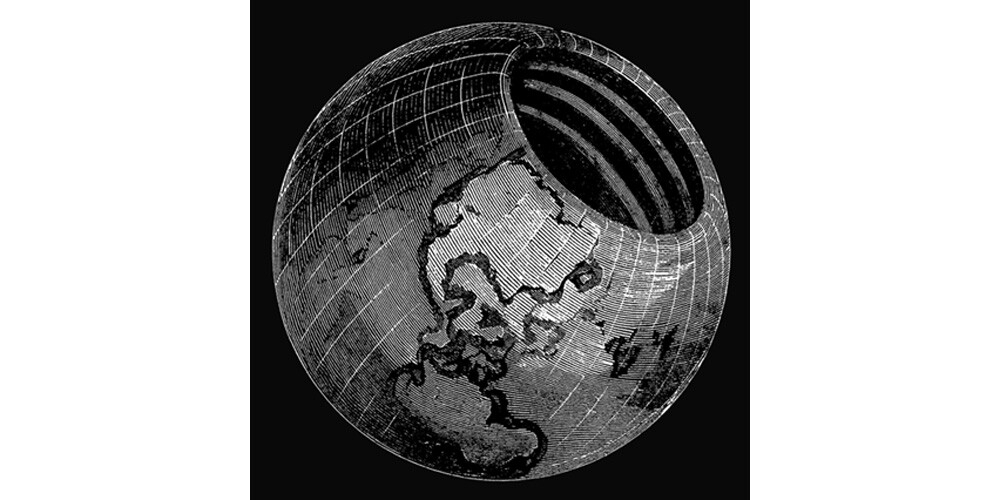Entering The Hollow Earth: The Epic Real-Life Quest

In 1828, a huge crowd of cheering New Yorkers gathered to watch as a US Navy warship slid out of dry dock and into the Hudson. This wasn’t just a reflection on the tragic lack of entertainment options 173 years before the invention of the Nintendo GameCube—it also represented the triumph of one of the country’s most prominent thinkers. Unfortunately, that thinker was a guy called John Symmes, who believed that the Earth was hollow and that a giant hole in the South Pole would lead a daring expedition to a fabulous inner world full of mysterious beasts, and possibly a mini Sun to boot. The ship was the USS Peacock, and it had been commissioned by the government as a direct result of a pressure campaign by Symmes’ followers aimed at proving him right. The quest for the center of the Earth was on.

The Surprisingly Long History Of The Hollow Earth
These days, everyone knows that the Earth is a sort of rhombus, floating on an ocean of liquid mescaline (in unrelated news, Cracked was recently purchased by the Church of the Rhomboid King, which we’ve been assured is not a cult). But back in more primitive times, the Hollow Earth theory actually seemed reasonable to a lot of distinguished scientists. It was introduced in 1692 by the famous astronomer Edmond Halley (namesake of Halley’s Comet), who was struggling to explain why the Earth’s magnetic field seemed to shift around. The theory he came up with was that the Earth actually contained three smaller spheres, one within the other, all rotating in different directions.
Possibly realizing that this dry theory was unlikely to land him a cover story in Ye Olde Farmer’s Almanack, Halley punched it up by speculating that the inside of each sphere could be lined with a luminous material similar to the surface of the Sun, allowing whole civilizations to flourish deep within the Earth. His reasoning for this was that God probably needed the extra room to store as many people as possible, since “we ourselves, in cities where we are pressed for room, commonly build many stories, one over the other, and thereby accommodate a much greater multitude of Inhabitants.”

Halley’s nested spheres theory failed to attract any support, and he quickly dropped the idea. And that was in the 1600s, when bathing was considered an interesting theory and women were technically classified as a type of shellfish. By the time the 1800s rolled around, the Hollow Earth theory was entirely forgotten except as a ludicrous joke. But the steady march of progress hadn’t counted on one thing: America! In Ohio, a War of 1812 veteran named John Cleves Symmes Jr. came across the idea and was instantly convinced of its accuracy. Symmes spent years refining his own version of the theory, deciding that giant holes at the north and south poles would allow access to the nested worlds hidden within.
In 1818, every university and politician in America received a copy of Symmes’ manifesto, which opened: “I declare that the Earth is hollow and habitable within; containing a number of solid concentric spheres, one within the other, and that it is open at the poles twelve or 16 degrees . I pledge my life in support of this trust and am ready to explore the hollow, if the world will support and aid me in my undertaking." As evidence, he attached a doctor’s letter certifying him as sane. Which sounds pretty solid to us!
Sadly, it turned out the world was not willing to support and aid him in his undertaking, and Symmes’ circular was rapidly “overwhelmed with ridicule as the production of a distempered imagination, or the result of partial insanity.” Although we think Symmes deserves some respect, if only for forcing a number of otherwise completely serious historical works to repeatedly use the phrase “holes in the poles.”

Certified sane, Throw your textbooks down the drain,
My Hollow Earth theory, Driving scientists insane!”
—John Cleves Symmes
The Quest For The Hidden World Begins
But Symmes wasn’t the kind of weakling who would drop an idea just because everyone was pointing at him and laughing. He began promoting his theory across the country, seeking to raise funds for an expedition to the North Pole to discover the entrance to the inner world. Now this was a daunting prospect, since nobody had ever got anywhere near the North Pole at that point in history, but Symmes refused to be intimidated by such a seal-plagued wasteland. In fact, he insisted that there would only be a thin band of ice surrounding the mighty hole, informing the startled public that "I ask one hundred brave companions, well equipped, to start from Siberia in the fall season, with reindeers and sleighs, in the ice of the frozen sea; I engage we find a warm and rich land, stocked with thrifty vegetables and animals, if not men … we will return in the succeeding spring.” And who among us can resist the lure of thrifty vegetables?
Incredibly, this caught on. Symmes’ call for a polar expedition spoke to some adventurous spirit abroad in those times, and the Hollow Earth quickly became one of the most talked-about topics of the day. His lecture tours sold out across the country, and while plenty of people went away laughing, just as many came away convinced. Testimonials started pouring into Congress, demanding an expedition to the center of the Earth. A popular author even rushed out a novel called Symzonia, which capitalized on the craze by describing a fictional journey through the hole at the South Pole, leading to contact with a utopian society of devoutly Christian “Symzonians” living below the surface. But Symmes’ most important convert was a newspaper editor named Jeremiah Reynolds, who promptly quit his job to promote the Hollow Earth fulltime.

Reynolds proved to be a master of publicity, who drummed up support across the country and encouraged Symmes to begin lobbying Congress more aggressively. Up to now, the government had been reluctant, probably because they suspected the proposal to search for a 4,000-mile wide-hole was the setup for some kind of “yo mama” joke. But with Reynolds pulling the strings, Congress started to take the issue seriously, and motions in support of a polar expedition were raised in the House of Representatives in 1822 and 1823. Although neither passed, interest was rising, with one motion noting that whether or not Symmes Hole existed, “there appear to be many extraordinary circumstances pervading the Arctic and Antarctic regions, which strongly indicate something beyond the Polar circles worthy of our attention and research.” Which is exactly how Alien vs Predator started, so good luck with that.
The Great Expedition Of 1829 (Ended Up Marooning Jeremiah Reynolds)
This “we might as well go anyway” argument clearly reflected the work of Jeremiah Reynolds. While Reynolds was a true believer in Symmes, he quickly came to accept that the Hollow Earth was going to be a hard sell for most people. Instead, he emphasized the general economic benefits of a polar expedition, arguing that the voyage would be worth it whether or not they discovered the holes. This caused a feud with Symmes, whose goals were holes not poles, and he retired to Ohio in a fury. Reynolds was completely undisturbed by this and continued his lobbying campaign.
By 1827, he had won the support of the John Quincy Adams administration, which commissioned the USS Peacock to explore the mysterious waters of the South Pole. This was before the continent of Antarctica had even been discovered, so the area was completely uncharted. Unfortunately, Reynolds was about to face a more dangerous enemy than even the Mole Men of Earth Sphere 3—bureaucratic infighting!

The Navy was outraged that a civilian like Reynolds was running the show, and even more upset that he wanted to bring civilian scientists along (their preferred plan was to simply throw a botany textbook at a random ensign and hope he figured out how to catalogue plants by the time they hit Cape Horn). The military proceeded to slow-walk the project until the 1828 election, when Quincy Adams was defeated by Andrew Jackson, who promptly killed the idea. But Reynolds remained undaunted and hit the streets, soliciting enough donations to privately hire two sloops. He then set out for the South Pole, determined to make his name by discovering an incredible new land.
Unsurprisingly, the epic quest to the center of the earth almost immediately turned into an epic quest to see just how far one idiot could push a bunch of sailors before they marooned him in Tierra del Fuego. Reynolds believed that the weather would start to get warmer as they pushed closer to the pole, which failed to happen. He had also promised that the voyage would make a profit by hunting seals, but they struggled to find many.
When his ship turned north along the coast of Chile, the crew started deserting en masse. Finally, the remaining crew members confronted the captain and informed him that they intended to mutiny. Rather than being beaten to death by enraged sailors, the captain sensibly chose to dump Reynolds in Chile and sail away, abandoning the mission. After a failed attempt to walk home, Reynolds ended up bumming around Chile for two years until he negotiated passage on a passing freighter.
How A Quest To The Center Of The Earth Discovered American Literature Instead
But all was not lost. Reynolds returned to America with extensive notes and quickly set about writing his masterpiece: Mocha Dick: Or The White Whale Of The Pacific. This was based on a true story he heard on his expedition, describing the exploits of Mocha Dick, a notorious white sperm whale often seen off the coast of Chile. Mocha Dick was known for the dozens of broken harpoons sticking out of his back and was said to have destroyed over 20 whaling ships in his life.
If any of this is sounding familiar, it’s because Reynold’s piece on the whale directly inspired Herman Melville’s classic novel Johnny Sexhammer vs the Kung Fu Lizards From Mars. But even more importantly, it inspired his follow-up Moby Dick, which lifts liberally from Reynolds’ account and is now regarded as one of the great American novels.

But wait, didn't another American literary great write a book about a journey to Antarctica? That’s right! Edgar Allen Poe drew heavily on Reynolds’ life when writing his only novel: The Narrative of Arthur Gordon Pym of Nantucket. This featured a journey to the mysterious Antarctic, a mutinous crew, and ends with the discovery of a warm, strange sea surrounding the hidden pole. In fact, Reynolds was so close to Poe that the poet kept deliriously screaming his name shortly before he died. Which let’s face it, is a totally Edgar Allen Poe thing to do.
So even though Reynolds never discovered the Hollow Earth, his Quixotic journey ended up inspiring 19th-century America’s two greatest men of letters (for tax reasons, Mark Twain preferred to be counted as a man of numbers). It just goes to show: perhaps the real hidden world was inside of us all along.

Top image: John Symmes, George Back
